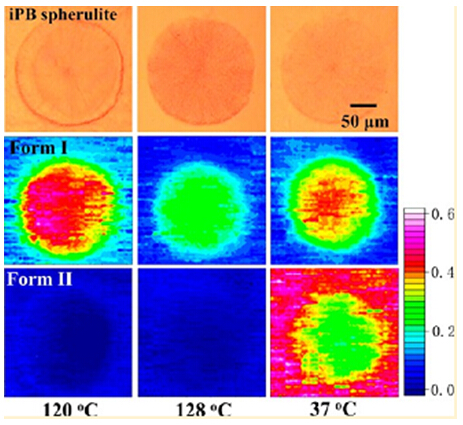The Application of Synchrotron Radiation Infrared Microspectroscopic Imaging in Polymer Crystallization
Fourier transformation infrared microspectroscopic imaging technique is new technology developed in recent years, which can give the space distribution of different elements and even different physical states and have been used in various regions such as Biology, chemistry and physics. NSRL purchased such setup and successfully applied it into National Synchrotron Light Source. With this technology, Professor Li achieved some great results in the study on polymer crystallization. Until now, seven articles have been published, 4 of which were published top journal of polymer. Just in last year, three articles have been made.
The crystallization behavior of semi-crystalline polymer has great effect on industry and science, the study on precursor attracted lots of attention. Nevertheless, the crystallization mechanism is still an open debate. An important issue is whether the intermediate state between crystal and melt exist. The study on melting and re-crystallization behavior of mesomorphic isotactic polypropylene (iPP) and isotactic polybutylene-1 (iPB-1) was made based on in situ Fourier transformation infrared (FTIR) microspectroscopic imaging technique at Hefei synchrotron radiation, FTIR and polarizing microscope.

Crystallization from memorized ordered melt (MOM) is investigated with iPB-1 spherulite. The result shows that after being partially melted at high temperature, a small portion of form I crystal of iPB-1 recovers back when the temperature is lowered,as shown in Figure below. This is different from a disordered melt, which crystallizes into form II directly. The recovery of form I crystal is attributed to the presence of MOM, which may keep the conformation order of form I crystal. All this experimental evidence suggests that MOM locates at the boundary of crystal and melt. This is in line with the physical picture of nonclassical nucleation and growth theory or the multistage approach, where a partially ordered melt layer locates at the boundary of crystal and melt.

The memory effect of a polymer is investigated with a mesomorphic iPP melt as the initial state with polarized light microscope and FITR. It is found that some ordered structures with higher thermal stability exist in the mesomorphic iPP melt. The high thermal stability of the ordered structure may be due to the random arrangement of helices of different handiness. We propose that the ordered structure accelerates spherulite growth, however, long melting times at 180 co can break down the ordered structure, leading to the formation of an ideal melt and restoration of the spherulite growth rate. This study indicates that a thermodynamically unstable ordered structure can survive in a supercooled melt for a long time and is involved in the crystallization process. The change in ordered structure with melting time and the effect of ordered structure on the growth process are shown in Figure below.

QQ截图20141021164657.jpg
2.jpg
Back

